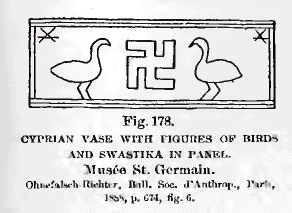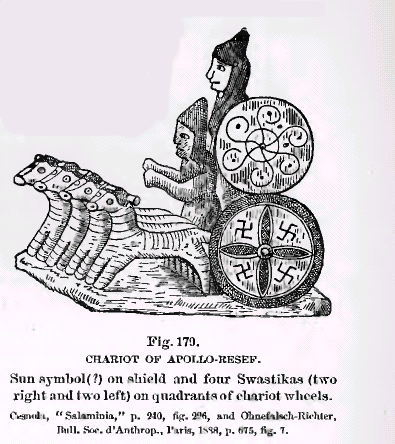

The Swastika
Dispersion of the Swastika

It represents the sacred palm under which Apollo, the god of light, was born.
* * * At Cyprus the palm did not appear only with the Phenicians; it was not known prior to that time (p.674).
The design shown in fig. 178 he describes as representing two birds in the attitude of adoration before a Swastika, all being figured on a Greek cup of the style Dipylon. (1)
Dr. Ohnefalsch-richter adds:
On the vases of Dipylon the Swastikas are generally transformed into other ornaments, mostly meanders. But this is not the rule in Cyprus. The Swastika disappeared from there as it came, in its sacred form, with the Phenician influence, with the Phenician inscriptions on the vases, with the concentric circles without central points or tangents.

He says (2) that the Swastika as well as the "Croix cantonnée" (with points or dots), while possibly not always the equivalent of the solar disk, zigzag lightning, or the double hatchet, yet are employed together and are given the same signification, and are frequently replace each other. It is his opinion (3) that the Swastika in Cyprus had nearly always a signification more or less religious, although it may have been used as an ornament to fill empty spaces. His interpretation of the Swastika in Cyprus is that it will signify tour à tour the storm, the lightning, the sun, the light, the seasons --- sometimes one, sometimes another of these significations --- and that its form lends itself easily (facilement) to the solar disk, to the fire wheel, and to the sun chariot. In support of this, he cites a figure (fig. 179) taken from Cesnola, (4) in which the wheels of the chariot are decorated with four
 Swastikas
displayed in each of the four quarters. The chief personage on the car
he identifies as the god of war and also the god of light, which he identifies
him with Helios. The other personage is Herakles-Meequars, the right hand
of Apollo, both of them heroes of the sun.
Swastikas
displayed in each of the four quarters. The chief personage on the car
he identifies as the god of war and also the god of light, which he identifies
him with Helios. The other personage is Herakles-Meequars, the right hand
of Apollo, both of them heroes of the sun. The supreme goddess of the Isle of Cyprus was Aphrodite-Astarte, (5) whose presence with a preponderating Phenician influence can be traced back to the period of the age of iron, her images bearing signs of the Swastika, being, according to Dr. Ohenfalsch-Richter, found in Cyprus. In fig. 180 the statue of this goddess is shown, which he says was found by himself in 1884 at Curium. It bears four Swastikas, two on the shoulders and two on the forearms. Fig. 181 represents a centaur found by him at the same time, on the right arm of which is a Swastika painted in black, as in the foregoing statue.
ENDNOTES:
1. G. Hirshcfield, "Vasi archaici Ateniesi," Annali dell' Instituto di corrispondenza archæologica, 1872, Tav. d'Ag. K. 6, 52. [Back]
2. Bull. Soc. d'Anthrop., Paris, 1888, pp. 674-675. Back
3. Ibid., p. 675. Back
4. "Salaminia," p. 240, fig. 226. Back
5. Aphrodite == Phenician Ashtoreth, Astarte == Babylonian Ishtar. Back
<< Previous Page Next Page >>
© 2004-2007 Northvegr.
Most of the material on this site is in the public domain. However, many people have worked very hard to bring these texts to you so if you do use the work, we would appreciate it if you could give credit to both the Northvegr site and to the individuals who worked to bring you these texts. A small number of texts are copyrighted and cannot be used without the author's permission. Any text that is copyrighted will have a clear notation of such on the main index page for that text. Inquiries can be sent to info@northvegr.org. Northvegr™ and the Northvegr symbol are trademarks and service marks of the Northvegr Foundation.

|